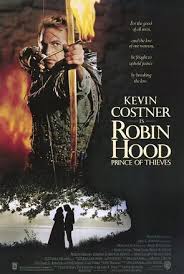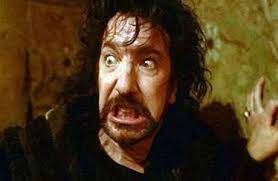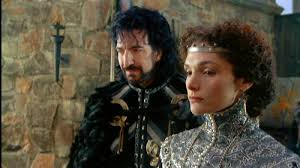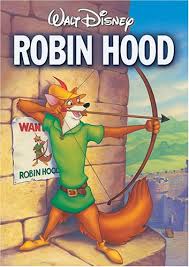I haven’t been able post in a long while because my husband and I just bought a house and spent most of last month moving and tackling moving-related stuff. But I’ve finally clawed out the time to tackle a movie, namely Robin Hood (2010, dir. Ridley Scott). Regular reader Lyn R. made a generous donation to the blog and requested that I review it. So Lyn, this is for you, and thank you again for your donation.

As I’ve already explored, all the evidence points to Robin Hood being a 14th century fictional character rather than a real historical figure. Most Robin Hood films situate the story in the 1190s, at a point when King Richard the Lionhearted is away on crusade. His brother Prince John is making trouble by governing England unjustly and demanding harsh taxation, which forces Robin Hood and his band out of outlaws into resistance against him. Usually, Richard arrives home and puts a stop to John’s hijinks right at the end of the film.
But Ridley Scott’s film follows a very different story. It opens right at the end of Richard’s reign, in 1199. As the film’s prologue text tells us “King Richard the Lion Heart, bankrupt of wealth and glory, is plundering his way back to England after ten years on his crusade. In his army is an archer named Robin Longstride.”
Right away the film is confused about the facts. Richard departed for the Holy Land in 1190, and left for home in 1192. On his way home he was shipwrecked on the Dalmatian coast, wound up falling into the hands of an enemy, and was held for ransom, finally being released in 1194 after a substantial ransom was paid. He returned to his French lands that same year and was back in control of England quickly, although he spent very little time there. So the typical Robin Hood film ends sometimes in 1194 or 1195, after Richard returns to England after his imprisonment.
But in Scott’s telling of the events, Richard (Danny Huston) has apparently spent four years in captivity, based on a comment his mother Eleanor (Eileen Atkins) makes to Prince John (Oscar Isaac), meaning he was released in 1196 and then apparently fought his way westward, plundering as he went, which is total nonsense. By 1199, he still hasn’t gotten to England and is laying siege to Chalus Castle in France. Robin (Russell Crowe) has apparently been in his service the whole time, which raises the question of what Robin was doing while Richard was in prison for 4 years. Were he and the rest of Richard’s army just killing time somewhere in Germany? That seems to be what the film intends, because no one in his army has been home since they left, including Sir Robert Loxley (who is NOT Robin Longstride).

Robin fighting in the Siege of Chalus
The film loosely follows the actual events of the siege of Chalus, which was a minor castle held by one of Richard’s recalcitrant vassals. During the siege, one of the cooks fires a crossbow bolt and hits Richard, fatally wounding him. (In reality, the injury itself didn’t kill Richard; rather the wound became gangrenous and he died more than a week later in the arms of his mother Eleanor.) So as a result, most of the movie takes place after Richard’s death during the reign of King John (1199-1216). That alone puts the film in a different category from pretty much all other Robin Hood films I can think of. There’s no Richard waiting in the wings to swoop in and stop John and lift Robin Hood’s outlawry.
After Richard dies, Robin and his friends Little John, Will Scarlett, and Alan A’Dayle (a name that makes me violently stabby, because it’s pretending to be the Irish O’Doyle) decide that they are sick of fighting and want to get home to England, so they desert and ride for the English Channel before the cost of a ship’s passage becomes unaffordable.
But unbeknownst to them, King Philip Augustus of France (Jonathan Zaccai) is plotting with Sir Godfrey (Mark Strong), one of John’s henchmen. Not realizing that Richard is dead, they hatch a convoluted plan to ambush and kill Richard and then turn England against the new king John so that Philip can invade and conquer England. This is a stupid plot because a far smarter thing to do would be to capture Richard instead of killing him, and then invade England in Richard’s name, claiming that John is trying to usurp Richard. This is the first, but far from the last, time the film has more plot than it can handle.

Mark Strong as the villainous Sir Godfrey
But Richard is already dead, and instead Godfrey winds up ambushing Sir Robert Loxley (Douglas Hodge), who is taking Richard’s crown back to England. He mortally wounds Loxley but then Robin and his men intervene and drive him off. Loxley makes Robin swear to return his sword to his father Sir Walter (Max von Sydow), and then dies. Instead, Robin decides to impersonate Loxley, I think so that he and his men can get free passage to England. They wind up having to deliver Richard’s crown to London, where Eleanor declares John king and immediately crowns him. (In reality, it wasn’t entirely clear that John was the heir. Maybe I’ll do a post on that later.) John, having instantly become a Douchebag with a Crown, decides that instead of rewarding Robin/Loxley with a ring, he will demand that Robin/Loxley go to Nottingham and get the taxes Sir Walter owes him.
Meanwhile, At Nottingham
Apparently Loxley is the Lord of Nottingham, because Sir Walter lives in a castle there. Nottingham itself is depicted as little more than a manor, with a small village of perhaps 200 people outside the castle and the fields in easy walking distance. It seems to have been a great city at some point because there is a massive ruined archway that characters ride through repeatedly.
In reality, Nottingham was a much more substantial settlement. Already by the 9th century it was of local importance, and by the 1080s it had a population of perhaps 1,500 people, making it by medieval standards a modest-sized town. By 1300, it had maybe 3,000 residents. Additionally, the castle was just plopped in the middle of some fields, which is a dumb place for a castle because it’s not very defensible; the real Nottingham castle is located on a rocky outcropping above the city. So the film’s depiction of Nottingham is entirely wrong.

Marion (Cate Blanchett) is Loxley’s wife, or rather widow. She is the daughter of some minor knight who for reasons never explained managed to marry Robert Loxley, who is clearly an important figure, since he is the heir to a castle and a close confidant of King Richard. A week after the wedding, Loxley left to join Richard’s forces, and Marion has been living, childless, with Loxley’s blind father Sir Walter. As the semi-evil but largely pointless Sheriff of Nottingham (Matthew McFadyen) points out, because she has no children and her husband is thought dead, when Sir Walter dies, she will be penniless because the Crown will claim the castle.
In case you couldn’t guess, THIS IS NOT HOW MEDIEVAL LAW WORKS. As Ranulf de Glanville, the leading English legal scholar of the 12th century lays out in his Treatise on the Laws and Customs of the Kingdom of England, when a man marries a women, he is required to give her a dower, property that becomes hers and is intended to support her when she becomes a widow. If Robert did this formally, he would have had to designate a specific property to serve as the dower; if he did not designate a specific property, she automatically gets 1/3 of his property as her dower. The dower property remains in Robert’s hands and out of his wife’s control, but in this case, since he’s out of the country, it would be in Sir Walter’s hands. If Loxley is assumed dead, the dower would now be in Marion’s hands.
Complicating this is the fact that Walter seems to be a vassal of the Crown, although that term is never used. This means that the castle and its manor are probably a fief that Walter holds (enjoys the use of) but doesn’t actually own. When Walter dies, the fief ought to pass to Robert, but if Robert is already dead, it would revert back to the Crown, which still probably has to honor Marion’s status as Robert’s widow and acknowledge whatever dower property she has a claim to. I say probably, because while Robert is the heir, he was never the vassal for the property, so maybe John could be a dick and just ignore Marion’s legal rights. More likely, what John would do is exercise his legal right to control the remarriage of Robert’s widow and sell her marriage to a man who wants to become the new fief-holder. John did that sort thing a good deal during his reign. So Marion would have a problem when Walter dies, because she either has to accept a marriage arranged for her by John or else pay John a sum of money for the right to control her own remarriage. But even if John tries to seize the fief when Walter dies, Marion still gets her dower property and won’t be thrown in a ditch.
And all of this raises the question of why the hell Sir Walter hasn’t remarried to have another son to act as his heir. Apparently he’s surprisingly unconcerned about things like carrying on his family line or taking care of his son’s wife. Given that he was once an extremely important man politically, this doesn’t make a whole lot of sense.
To make matters worse for Marion, there are bandits around Nottingham, and Marion is apparently the only defensive force. She knows how to use a longbow (a century before the English adopted that weapons, but that’s the least of the film’s anachronisms), but despite that, at the start of the film, bandits break into the storehouse and steal all the seed-grain, so Marion has no grain to plant in the fields. The local church has grain that has been tithed to them, but the priest insists that the grain goes to the archbishop of York. Why the archbishop of York should have a claim on the grain from the village church of Nottingham is unexplained, since medieval Nottingham was part of the diocese of Lincoln in the archdiocese of Canterbury, but who knows? Medieval clergy just make up the rules as they go, remember?

Cate Blanchett as Maid, err Wife Marion
Enter Robin
Robin and his men show up as themselves, having apparently forgotten that Robin is supposed to be pretending to be Robert to get John’s taxes. Robin turns over the sword and tells Walter and Marion that Robert is dead, but Walter promptly proposes that Robin pull a Martin Guerre and pretend to be Robert. In exchange he will give Robin the family sword.
Are you starting to notice that this film has way too much plot? The film gives Robin not one but two different bouts of pretending to be Robert Loxley. Godfrey has tricked John into allowing him to rampage around England collecting taxes in a brutal fashion in order to incite the barons of England against John. And Philip’s troops have snuck into England to help Godfrey. But William Marshall (William Hurt) has warned Eleanor about what’s going on, and Eleanor convinces John’s wife, Isabella of Angouleme (Léa Seydoux) who is Philip’s niece, to warn John of what’s going on so John can stop it. But John’s a Douchebag with a Crown and doesn’t want to negotiate with his barons. And meanwhile, Friar Tuck (Mark Addy) and Robin/Loxley orchestrate the theft of the church’s grain when it is being shipped to York, and then they sow the grain in the middle of the night.
But Wait, There’s More!
As it turns out, Sir Walter knew Robin’s father. How he connects the two men is unclear, given that he can’t see and Robin’s father has been dead since Robin was a little boy (he only has faint memories of the man). Apparently the connection is that both were called ‘Longstride’, because the movie mistakenly thinks that people had hereditary last names in the 12th century.
Spurred on by a clue written on the sword’s hilt, Sir Walter tells Robin that his father was a mason who built a monumental cross in Nottingham. But he was also a political revolutionary who wrote a charter of liberties for a group of barons, the same group who are now rebelling. Why a common stonemason would be able to write or to lead a group of nobles is never explained, and is pretty silly. But it turns out that Longstride Sr anticipated the Magna Carta by about half a century, since he seems to have been active in the 1160s or 70s. Sir William now has the charter, and he sends Robin off to the meeting of the barons and John. So Robin/Loxley proposes that John accept a charter of liberties that will establish equality so that John can be stronger because the people will love him, because 12th century Englishmen think just like 21st century Americans. John agrees and the barons call off the rebellion just in time for Robin/Loxley to lead their troops to rescue Nottingham from Godfrey’s men, who are plundering the village, killing Sir Walter, trying to burn people alive and trying to rape Marion.
When that’s done with, the film still isn’t over. Robin/Loxley leads everybody, including the bandits and Marion and Tuck, halfway across England to Dover, where King Philip’s troops are trying to stage the most absurd amphibious landing in cinematic history. Robin and Marion both suddenly discover that they know how to fight with swords from horseback, so they lead a charge on the beach and foil Philip’s invasion and force him back to France, and everyone lives happily ever after except that John is Douchebag with a Crown and burns the Magna Carta and outlaws Robin Loxley aka Robin of the Hood (cuz apparently Nottingham is in the Inner City) and that’s how Robin Hood became a bandit and almost established American democracy in 1199.
There’s a lot for me to comment on here, so we’ll be dining out on this movie for several blog posts.
This post was made possible by a generous donation. If you have a movie you particularly want me to review, if you make a donation and tell me what film you want me to review, I’ll do at least one post on the film, assuming A) I can get access to the film somehow and B) I think it’s appropriate for the blog. (If there’s an issue, I’ll let you pick another movie.)
Want to Know More?
Robin Hood is available on Amazon.
If you want to know more about Robin Hood, the place to start is J.C. Holt’s Robin Hood (Third Edition) . It’s a really good exploration of the historical issues with the Robin Hood legend. But if you want to dig a little further, take a look at Maurice Keen’s The Outlaws of Medieval Legend
. It’s a really good exploration of the historical issues with the Robin Hood legend. But if you want to dig a little further, take a look at Maurice Keen’s The Outlaws of Medieval Legend , which discusses Robin Hood as well as several other real and folkloric outlaws.
, which discusses Robin Hood as well as several other real and folkloric outlaws.















































